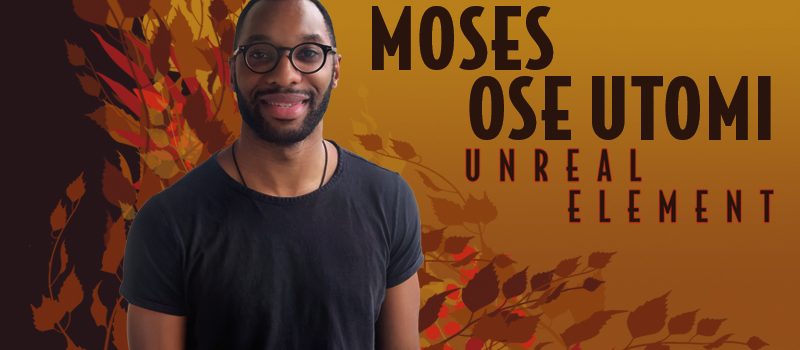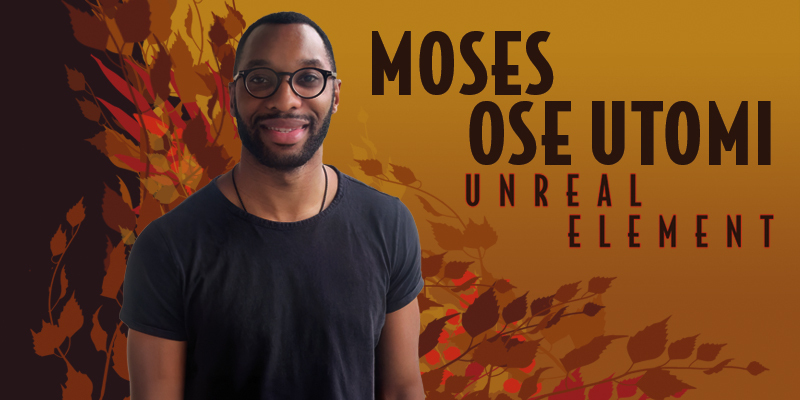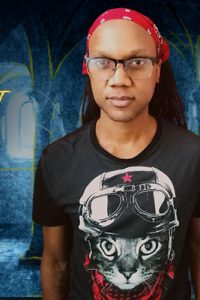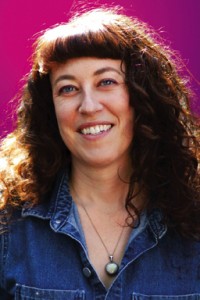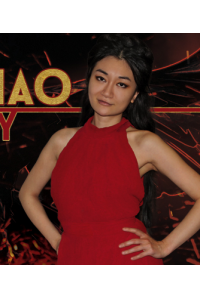Moses Ose Utomi: Unreal Element
MOSES OSE UTOMI was born July 26, 1988 in San Bernardino CA and grew up in Las Vegas NV. He studied psychology as an undergrad, then attended Sarah Lawrence College, where he earned a MFA in creative writing. Utomi is also a lifelong martial artist.
He began publishing work of SF interest with “The Story of a Young Woman” (2018, as Ose Utomi). His short work also includes the Forever Desert novella series: The Lies of the Ajungo (2023), The Truth of the Aleke (2024), and a forthcoming third volume. His debut novel, YA fantasy Daughters of Oduma, appeared in 2023, and a sequel, Children of Useyi, is forthcoming.
Utomi is a self-described nomad who has traveled extensively, and currently lives in San Diego CA.
Excerpt from the interview:
“I lived abroad for a while, off and on, and I was abroad when I wrote my first book. It has never been published and probably won’t be. But when I came back, I thought, ‘I’ll sell it and I’ll be a millionaire and I’ll buy an island.’ And that didn’t happen – okay, hasn’t happened, not didn’t. With that first book, I was querying, so I had to figure that game out. I had a meeting with an agent, and it was so exciting. It was my first time being on the publishing side of things as opposed to the creative side. That deal didn’t work out, but right after that, the opportunity arose to take a certificate in publishing.
“I learned a ton there. It was so informative – it really taught me how to query properly. I got to meet a ton of agents and a ton of editors. I heard so many stories from the industry about how books are acquired, how auctions work, and without that course, I wouldn’t fully understand those parts of publishing. It helped me with the query letter I used for Daughters of Oduma. Now I think about the industry as a series of business relationships, not just a lone artist fighting the world.
“In my experience, conventions can be helpful, because everyone is so welcoming. Everyone is so nice, and everyone is so willing to share their wisdom and connect with other people. Obviously there are people who land deals at conventions – they meet an editor and negotiate a contract. Those things happen, but the connections with other people is a big part of it.
“I was a fan of the industry for most of my life, so now, I forget that I don’t get to be a fly on the wall anymore. I’m not very well-known, but still, going into a room as a fan instead of going into a room where some people know your work or have heard your name – that’s been a big change, and that’s been interesting. I’m in a middle space, right now. I’m not Victor LaValle, where everyone knows you. But I’m also not 22-year-old Moses, who can walk around a convention for a month and nobody will recognize or call out to me. Everyone who’s going to read this interview: Go to conventions, and be honest, and meet people, and shake hands, and say hi to your heroes.
“I don’t think I’m great at short fiction. I have so much admiration for it. When I was an aspiring writer trying to break in, I would see all the names in Clarkesworld and Nightmare and Lightspeed, and they were superheroes to me. I’ve been rejected so many times from Clarkesworld – as we all have, you know? I still haven’t tracked that game, to be honest. I don’t publish prolifically in short fiction. My rejection rate is still very high.
“My process for short fiction is similar to my process for novellas, which is different from my process for novels. I can hold maybe 80 pages of organized and coherent story in my brain that’s. After that, it gets very tough, and I need to start outsourcing to documents and to spreadsheets and all these other things.
“With a story or short novella, I sit down with this very distinct image/fever dream in my brain that I’m the conduit for, and I just need to get into the right mental space so it can come out properly. Whereas with long novellas or novels, there are some images I want to use, and scenes that I find interesting, but I need to sit down and be the architect. I need a character sheet, and a scene sheet, and typically I’ll have a document where every single scene is broken down: which characters are in this scene, who are the new characters, who are the recurring characters, what is the main emotional purpose, and what is the main narrative purpose. Without that, it’s very easy for me to lose the plot if a story is 100 pages long – even after 50, things start to seep out.
“I don’t have much of a background in poetry, but the effect of a short story is similar to a poem, in the sense that I’m building up that final line: The whole thing is about getting to this final point in a very stripped-down way, so that final message or emotion I’m trying to reveal hits as hard as it can. That becomes difficult as a project gets larger, just because you probably don’t need 200 pages to hit that final moment. There’s a reason poems aren’t 200 pages long, typically. You have so many more ideas you’re trying to grapple with for a novel – now that I have all these things I’m trying to hit, it feels less like an emotive drive, and more like a mechanical drive. It’s using the scientific versus creative side of my brain. All my work uses both, but short stories and novellas really are emotion-driven and -fueled, and serve to get a cathartic emotion or feeling out. Whereas, with novels, I’m designing a project, and feel more like an assembly-line manager – I’m building something.
“Most of good writing is a combination of noticing and empathy – which maybe are the same skill, to some extent. You need to feel how a character would feel in a given situation. So much of who we are is dictated by our circumstances, and I apply that to my characters, and then think, not just about how I would behave, but about what makes sense as a behavior. As I build the character, I ask, ‘What makes sense for this character? What makes sense for a person in this situation?’ With no judgment – this is just what has happened to this person, this is the circumstance they find themselves in. Empathy is essential to building a character.
“I’m very proud of the characters I made in Daughters of Oduma. Whenever somebody compliments the characters, I appreciate it immensely, because I spent a lot of time on that. For that project, specifically, I made a character web, which is an idea that I’ve stolen – like all good fiction ideas. Do not invent your own if you don’t have to. There are great ideas out there. The idea – at least as I applied it – is I had my central character, Dirt, the protagonist, and then I extracted specific aspects of her into other characters, and built an identity around each specific aspect.
“So I took Dirt’s determination and devotion to her family, and I made those characteristics the spine of one character. I took her uncertainty about the future, and I made that the core of another character. Every character has an interaction point with Dirt in a way that’s meaningful, because these are really important aspects of who she is. Every character also has interaction points with other characters, because they all have the same core that they look back to – in this case, Dirt.
“That book is about a sisterhood, about people living in a family and in community with each other. For that reason, it was a really good way to build those characters. They all have things in common, and they all have things that are deeply different. There’s an idea that we dislike people who have the same flaws we do, because it causes us to see our own flaws in a way that’s not comfortable. Dirt sees her own uncertainty in other characters – in this case, her sister – and gets really irritated, and then has to reckon with that. That dynamic makes for a lot of good interactions.
“My previous book, the one I came back from abroad with, didn’t sell, and wasn’t received the way I wanted by agents, so I was like, ‘Let me sit down and figure out what I’m writing and why I’m writing. What is this thing I’m doing?’ It was a combination of trying to play the market and also being sincere. What is it about me that I find valuable? What is it about me that I care about, and that I love? Let me write about that. If nobody is going to like my books, at least I can write about something I care about.
“I thought about four pillars of my identity, which are: I have a Nigerian American, West African background; I come from a very large and close family; I’ve practiced martial arts since I was a kid, and used to be a competitive kickboxer; and epic fantasy has been part of my whole life. So I decided to combine all four of those things together, and got a West African-inspired epic fantasy about a family of girls competing in a martial arts tournament. That was really how the novel came together.
“The story didn’t change substantially during the writing process. The structure and the way it played out changed quite a bit. I’d originally written the book as a single POV novella – I write everything as a novella to start with. I don’t know why. That’s just how much my brain can hold. I thought it would be kind of a quick novella about this girl Dirt coming out of retirement to win a tournament. Then, as I started writing the characters, I realized the sense of family was so integral to her, I couldn’t fully tell that story without dipping into the other characters’ heads. I needed their perspectives to really round things out. Once you have five point-of-view characters, that’s a hard thing to do in a novella, right? When every character has their own arc, story, and motivations. The first draft was 80 pages, and the last draft was 360-something. It grew quite a bit.
“I’ve read books where not every character gets an arc, but I needed that for this story, and it absolutely makes the book. I’ve had some people ask, ‘If you’re writing twice as many words, is it twice as hard?’ No, it’s a hundred times as hard. The book becomes so much more complex. When you add one more character with their own motivations and thoughts and their story that needs to be told, it gets 50 times harder. When you add four characters, it just gets harder. It becomes very delicate. I’d make a change to one scene that destroyed the whole book, and everything started collapsing. It’s very house of cards. It all became more difficult, but it was necessary.
“Daughters of Oduma, at its core, is about learning to believe the people who see you, when you can’t believe in yourself. That’s really what Dirt grapples with. Part of me wanted to tell a story about an underdog, but it felt more honest to tell the story about somebody who has all the talent, and everything they need to succeed, but who doesn’t believe in themselves. I’m sure a lot of people have encountered that situation, where the people who love and support you can see the best of you at times when you can’t. For Dirt, it really became about grappling with that, and accepting that maybe she can’t believe in herself actively, but she can trust that the people who care about her would never waste their belief on somebody who doesn’t deserve it. That’s the main story.
“I did not write it as a YA book. That ended up being how it was sold and positioned, and after we sold it, I made some edits to more clearly render the message and the character motivations. I’m a huge fan of ambiguous character motivations and messaging, which is not always good, but it’s what I’m into. With my adult works I’m very comfortable saying, ‘We don’t know if this character is good or bad; we don’t know if this is a villain or a hero.’ That’s kind of what it’s like being an adult – things are murky. But with YA, I wanted to make it a little more clear, so the message is a little less open to interpretation, and the motivations are a little more clear and easily digested. Other than that, and grading some language down a little bit, I didn’t change much.
“The sequel is called Children of Useyi. In first book, it’s revealed that there are five gods on this island, where there are no adults. One of the gods is Useyi, the god of forgotten memories. His name appears in the second book, so I’ll tell you that much, but I’ll stop there because of spoilers. The book revolves arounds the mystery of why there are no adults on this island. We see Dirt and her sisters navigating a new life and trying to solve this mystery.
“Having deadlines definitely changes the process. The process is stressful – I’ve found it’s very different. If my career goes on, I hope that gets easier. It was so foreign to me, after a lifetime of writing at my own pace. I get most of my inspiration at 3:00 a.m., I jot things down, it’s messy, I put it together, I send it to my friends to review, they send it back to me, I change it, and I send it to my friends again. That whole process was gone for the second book. Some of this is on me. My editor will say, ‘When can you get it to me?’ And I’ll say, ‘Tomorrow.’ Very stupid. I make time frames that are hard, and it’s me racing against the clock. I think the outcome is the same – it’s hard for me to send off a story unless I feel a certain way about it – but now it constantly feels like there’s somebody breathing on my shoulder, while before, I was writing things that nobody asked for. It was just me, doing something for me. Now it’s homework. It does help to have a professional editor look over your work. Some of the loss of process time is mitigated by the fact I have geniuses to look over my work and fix it.
“The idea for The Lies of Ajungo came from a simpler place than Daughters of Oduma. I was on the subway heading home from work when I lived in New York, and the first line of Ajungo came to me: ‘There is no water in the City of Lies.’ I don’t know where it came from, or why I was thinking about water, but that hit me, and I literally pulled out my laptop right there on the subway – which isn’t always safe! I wouldn’t recommend that to anybody in NY. But I started writing. ‘What does this mean? Why is there no water in this place that I haven’t figured out? Why is it called the City of Lies? What is going on here?’
“It was a very meditative writing process. I write best when I am able to ignore things that I should perhaps be paying attention to. There is something like deliberately creating tunnel vision that helps my writing. Being on the subway and having someone flinging poop on one side, somebody breakdancing on the other – those things I can tune it out. It felt like a deliberate meditation in the face of chaos, so the book became this meditation on thirst and desire and storytelling and history. It was way more spontaneous than I think anything else I’ve ever written.
“When I wrote The Lies of Ajungo, I knew there were more stories I could tell in the world of the Forever Desert, so the second book, The Truth of the Aleke, takes place 500 years after the first book. I knew, if there was any story left to tell, it had to add a historical lens. I wanted to look back on the events of the first book as historical rather than just things that previously happened. That was the idea for the trilogy.
“The books are very concerned with mythology. I’m not a mythologist, in the sense of doing formal study; I just read fantasy. There’s something interesting about the way we discuss mythology – there’s a certain patronizing attitude towards it. When we say mythology, it’s inherent that it’s untrue, and simple. You know what I mean? The events of our lives will eventually be mythology, if we’re awesome. If we’re boring, we’ll be forgotten, but if we’re amazing, we’ll become mythology. That’s the best-case scenario for a life. I wanted to explore: What does it feel like to see the people you love become mythologized? Obviously, we won’t be around for that, but with the book series, I can do it. We have Tutu in the first book, and everything he goes through and experiences, and by the second book, Tutu is a historical figure. In the third book, he’s fully mythologized. This is my take on it – it might not be how history really works, but you get to see how time and storytelling change and recontextualize things. If I give the reader that kind of perspective over the course of a thousand years, they can see how time magnifies and complicates the importance of any individual human life.
“I’m very self-deprecating and hard on myself, so it’s hard to talk about things I do well. I think I did a good job of defamiliarizing water. A goal of the first book was to make water feel new again. Obviously, this is a kid coming from a land that has multigenerational droughts, where water is rationed even in the best of times, so he has a very different relationship with water than most of us. When he encounters water, in any quantity, he’s either mind-blown by how much there is, or caught off guard – in one scene, he realizes water doesn’t smell like how he thought. He thinks of water as something you drink from a skin. That’s the only way he’s ever had water, so it’s a surprise when it doesn’t smell like camel hide. He goes swimming at one point, and if you’ve never been inside water that could submerge you before, you don’t know that things move slower underwater, that bubbles escape your lips, all these things. That was important thing to me, and I hope I did that well.
“Oh, sweet, sweet Osi. He’s a bit older than Tutu, he’s 17, and a peacekeeper in his city. In their city, they have kind of a few different tiers of keeping the peace. He’s a junior peacekeeper, essentially like a cadet to become a town guard, and he is a kid really driven by a sense of right. He is deeply concerned with doing the right thing, and the book opens on a scene where he does something that he feels is right, and people disagree with it, and that really hurts him. He’s older than Tutu, but a bit more innocent. I used to teach young kids, and their sense of fairness and justice is so sensitive and so acute that when they feel something is unjust, it really hurts them, deeply. As opposed to adults, who know things are unfair, but you just get over it. Kids don’t have that ability yet. I remember one time I was teaching, and I gave a kid stars who didn’t deserve them, to try and cheer him up because he was having a rough day, and this other kid was like, ‘But I was better than him – why does he get stars and I don’t?’ I ended up giving the other kid a star too, but it was too late. There’s was a meltdown, and everyone’s crying. But, from his perspective, I get it: ‘Stars are the currency of good behavior, and I’m being good! This doesn’t make sense.’ Osi is very much a child, in that sense: He wants to do right and he thinks the world should operate justly.
“Osi lives in a city that has been besieged for hundreds of years. They’re under siege by a figure called the Aleke, who is – as far as they know – immortal and very cruel, and who has done horrible things to get to a position of power. He’s essentially the lord of the entire Forever Desert, and this is the last city, and he has them under siege until he can break them. He brings his forces to attack the city, and Osi steps up to defend the city even though he’s poorly trained and a child. For his bravery, he’s elevated to the highest level of the city’s special forces called the Truthseekers. These are their Navy SEALs, their Justice League, the top-of-the-line warriors. He’s sent on a mission to, essentially, travel across the Forever Desert, find and assassinate the Aleke, and bring back the city’s magic which the Aleke stole. His journey is really one of learning a lot about the world – in the same way that Tutu did. The Forever Desert is a place to learn.
“There’s another book coming. I’m a huge Fonda Lee fan, and I remember reading her essay about Jade Legacy and how trilogies can function and what a third book can do. I was so enthralled – when I read Jade Legacy I was like, ‘This is one of the coolest conclusions to a trilogy I’ve ever read.’ I was impressed, mechanically, by what it did. So with my third book, the goal is to give the reader a sense of how history becomes mythology. What does that mean? How do we, as people, operate within the system of this inevitable process? The third book helps to recontextualize the events of the previous books, so the reader sees them in a very different light. It both grows from and contextualizes the previous books.
“The worlds of the two series are very different. The Forever Desert is a very parched and difficult world, while the world of Daughters of Oduma is quite a bit more forgiving. They’re similar in the sense that they both come from me, and I’m sure there are things I’ve put in both that are going to appear in most of my works. They operate very differently and have different messages, though. The Forever Desert is, despite the lower page count, a bit larger – it’s trying to present a larger message about people, humanity, society. Daughters of Oduma is much more intimate, about family, and individual psychology. Those worlds are on opposite sides of the limits of my spectrum. They both do have a sense of found family, though.
“Fight scenes, too. Daughters of Oduma explicitly deals with martial arts. The Forever Desert series has fight scenes, and I think those are almost always influenced by my martial arts background, mostly in the sense that I tend to shy away from writing big battles. The art of war is very martial, yes, but for me, martial arts has always been a one-on-one thing. I’m typically not one of those authors who’s going to give you flanking and cavalry charges. For me, fights are very psychological, and very individual.
“When we see movies with Rambo or Jon Snow or whatever in a battle, it’s just chaos, you’re cutting people down and they’re just dying left and right. When you strip that down, these are individuals, these are humans (usually), and so when you can see them at an individual scale, and it’s five people fighting instead of a thousand, it feels a lot scarier, a lot more high-stakes. A thousand people can die and it doesn’t mean anything. If it’s five people and somebody dies, it means a lot.
“There are a few things I keep on top of my brain when I work on each book. I’m aware of how they’re in conversation with each other and how they’re distant from each other. The titles do a lot of that – one is more about lies, and one is a little bit more about truth. Lies is more about thirst, and Truth is more about hunger, in whatever ways those are different. They each have a distinct message, but they’re deeply in conversation with each other. They’re each their own meditation on different aspects of the same concerns.
“I thought I was being so smart when I set a sequel 500 years after the previous one: ‘I’m a genius. I don’t need to have the same characters, I’m free! I’m not beholden to anything.’ I was not a genius. I wasn’t even smart. It’s so much harder than I thought! The way trilogies work, I learned belatedly, is the second book takes what you’ve established in the first book and just runs with it. When it’s set 500 years later, the characters are gone. It’s a whole new thing, and almost all the advantages I set up the first book are gone. I had to re-establish the world, because it changed a lot in 500 years. I have to get readers to invest in a new protagonist who I hope they don’t hate, because if they do, then everything falls apart. The minute I started working on book two I was like, ‘Man, I’m just a dumdum.’ If the novel had picked up a day after the previous book it might have been easier, but that time skip was tough.
“But having the 500-year-gap, as difficult as it was, made the coolest puzzle ever. Writing book two was like solving a Rubik’s Cube. There were lines I was able to lift directly from the first book that now mean something different. When you really finish a puzzle, that moment of dopamine – that was amazing.
“I’m working on book three of the Forever Desert right now. I’m so grateful to be able to write this book, and I can’t express how excited I am for it. It’s insane to me that anybody is going to read this book, because it’s so personal, and what I’m doing is so idiosyncratic – it’s just me being myself in literary form, and it’s wild that people appreciate it. I felt that same way about Lies, and I’m going to feel that way tenfold about this last book. I hope it’s really satisfying. I’m really confident that what is set up in books one and two will feel incredible once you get to book three. They’re really going to pay off, and that book is where a hundred percent of my focus is right now. I’m so excited for y’all to read it.”
Interview design by Francesca Myman
Read the full interview in the March 2024 issue of Locus.
 While you are here, please take a moment to support Locus with a one-time or recurring donation. We rely on reader donations to keep the magazine and site going, and would like to keep the site paywall free, but WE NEED YOUR FINANCIAL SUPPORT to continue quality coverage of the science fiction and fantasy field.
While you are here, please take a moment to support Locus with a one-time or recurring donation. We rely on reader donations to keep the magazine and site going, and would like to keep the site paywall free, but WE NEED YOUR FINANCIAL SUPPORT to continue quality coverage of the science fiction and fantasy field.
©Locus Magazine. Copyrighted material may not be republished without permission of LSFF.


